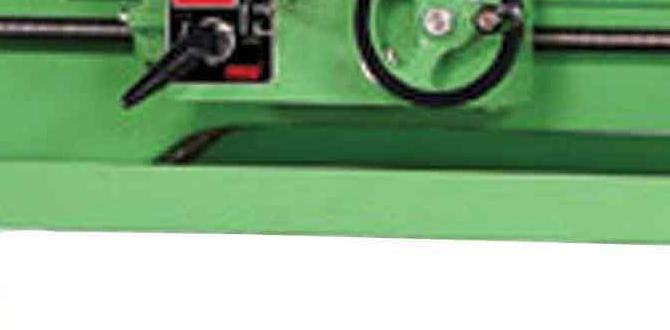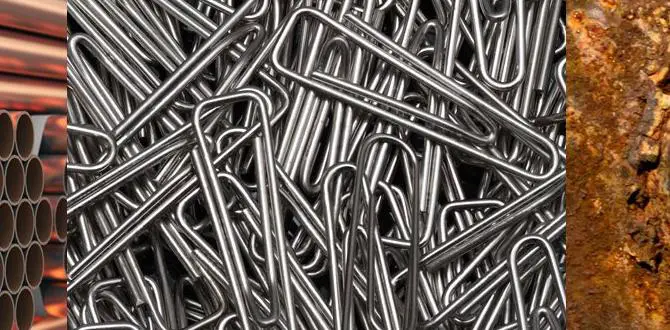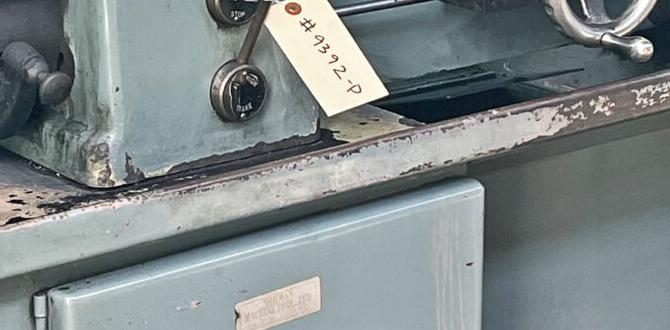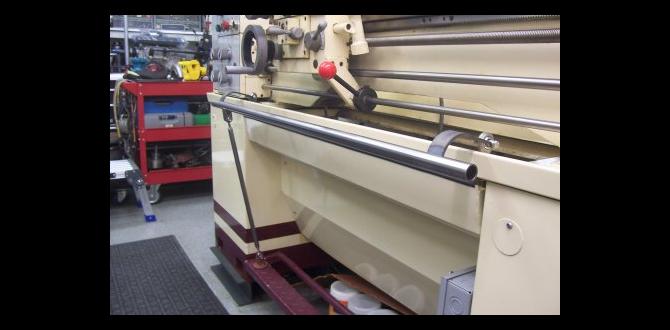Have you ever wondered how metal objects get their smooth, shiny surfaces? That’s where a lathe comes in. A metal lathe can create amazing surface finishes. But if you’re just starting, it might seem a bit tricky. What if I told you that mastering a lathe can unlock new possibilities for your projects?
Imagine making your own metal parts that look as good as ones sold in stores. With the right skills, you can do this. Learning about lathe surface finish is an important step for beginners. It can help you turn your ideas into reality.
Did you know that the way you cut metal affects how it looks? Different techniques can change the finish. In this article, we’ll explore simple methods to achieve great results with your lathe. Get ready to discover the world of metalworking!
Lathe Surface Finish: A Guide For Metal Lathe Beginners
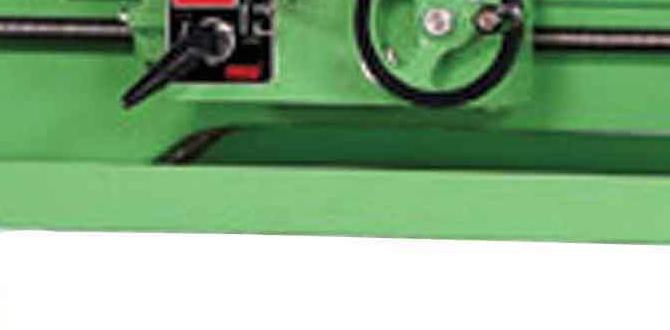
Lathe Surface Finish: Metal Lathe for Beginners
Using a lathe can be exciting, especially for beginners wanting to create smooth metal surfaces. A good surface finish is essential for the final product, affecting both function and appearance. Did you know that tiny mistakes in technique can lead to rough finishes? Beginners should learn about cutting speeds, tool types, and material choices to achieve a great result. With some practice and the right tips, anyone can master the art of lathe work!Understanding Lathe Surface Finish
Definition and importance of surface finish in machining. Common surface finish measurement metrics (Ra, Rz, etc.).Lathe surface finish is all about how smooth a metal surface looks and feels after machining. It’s crucial since a better finish means less friction and a longer-lasting part. Think of it like polishing a shoe; a shiny finish makes it look snazzy! Common ways to measure this smoothness include Ra (average roughness) and Rz (average maximum height of the profile). These metrics help you know if your surface is ready for action or still needs a bit of TLC.
| Surface Finish Metric | Definition |
|---|---|
| Ra | Average roughness of the surface. |
| Rz | Average height difference between peaks and valleys. |
Key Factors Influencing Surface Finish Quality
Role of tool material and geometry. Impact of cutting speed and feed rates.Several key factors affect how smooth a metal surface becomes. First, the tool material and geometry play a vital role. A sharp tool made from hard material creates a fine finish. The tool’s shape also matters; certain shapes cut more smoothly than others.
Next, the cutting speed and feed rates show their influence. Faster speeds can lead to a better surface but may cause more heat. On the other hand, slower speeds allow for a finer touch. Finding the right balance is essential for beginners.
Why is tool material important for surface finish?
Tool material affects cut quality. Harder materials create less friction, leading to smoother finishes.
Factors Affecting Finish Quality:
- Tool Material: Hard materials work best.
- Tool Geometry: Shape impacts smoothness.
- Cutting Speed: Faster speeds can improve finish.
- Feed Rates: Slower feed improves detail.
Setup and Preparation for Lathe Work
Importance of workpiece setup and alignment. Tips for selecting the right tools and settings.Setting up your workpiece correctly is like having a sturdy chair. It keeps everything steady. If your piece wobbles, you might end up with a lopsided donut instead of a perfect circle! Start by checking alignment. Use a center finder for accuracy. Also, make sure you choose the right tools. For beginners, a quick reference table can be super handy:
| Tool | Use |
|---|---|
| Parting Tool | Cutting narrow grooves |
| Facing Tool | Smoothing the end of the workpiece |
| Turning Tool | Creating shapes and profiles |
Pick the right settings too! If your lathe is set too fast, you may end up with metal confetti instead of chips. A steady hand and a good setup will have you crafting masterpieces in no time!
Techniques for Improving Surface Finish
Best practices for cutting techniques. Importance of lubrication and cooling methods.To get a shiny surface on your metal, effective cutting techniques are key. Start by choosing the right speed and feed rate. Too fast? You’ll make a mess. Too slow? It can get ugly! Remember to use sharp tools. Dull ones can ruin your day. Lubrication is also a must. It helps reduce heat and friction. Cool temperatures keep the metal happy. Using cutting fluid can be the difference between a shiny masterpiece and a rusty disappointment!
| Best Cutting Techniques | Tips |
|---|---|
| Speed Control | Find the sweet spot – neither too fast nor too slow. |
| Sharp Tools | Keep your tools sharp for smooth cuts. |
| Lubrication | Use cutting fluid to cool and protect. |
Following these techniques can lead to a surface finish that shines brighter than your neighbor’s car. Remember, a little care goes a long way!
Common Mistakes and How to Avoid Them
Typical errors beginners make in achieving surface finish. Tips for troubleshooting and correcting issues.New users of metal lathes can run into common mistakes that mess up their work. Rough finishes often come from bad tool choice or incorrect speeds. Not checking your material can cause undesirable marks. If you see these problems, try these tips:
- Use the right tool for your material.
- Adjust speeds to match your project.
- Clean your lathe regularly.
With practice and care, you will see a big difference in your surface finish!
What are common mistakes when using a lathe?
Common mistakes include using dull tools, incorrect speeds, and not checking the material.
Tips for Fixing Issues:
- Always sharpen your tools.
- Adjust speeds based on the material you work with.
- Inspect materials before starting a project.
Maintenance of Lathe for Optimal Performance
Regular maintenance tips to ensure consistent surface finish. Importance of calibrating and inspecting lathe equipment.To keep your lathe running smoothly, regular maintenance is key. Clean your lathe after each use; chips and dirt can create a ruckus! Always check the oil levels—think of it like feeding your machine its daily snacks. Calibrating your equipment helps ensure exact measurements. Testing and inspecting it can prevent frustration later. A happy lathe means a shiny, smooth finish on your metal. Remember, a well-oiled machine is a happy machine!
| Maintenance Task | Frequency |
|---|---|
| Clean Lathe | After each use |
| Check Oil Levels | Weekly |
| Calibrate Equipment | Monthly |
| Inspect Parts | Every 3 months |
Conclusion
In summary, using a lathe can help you create smooth surfaces on metal pieces. Start with simple projects to practice your skills. Remember to choose the right tools and settings for the best finish. Keep experimenting and learning from your experiences. For more tips and techniques, check out beginner guides and videos. Happy machining!FAQs
Sure! Here Are Five Related Questions On The Topic Of Lathe Surface Finish For Beginners:Sure! Here are five questions about lathe surface finish for beginners: 1. What is lathe surface finish? Lathe surface finish is how smooth a metal piece looks after using a lathe machine. 2. Why is surface finish important? A good surface finish helps parts fit better and last longer. It also looks nicer. 3. How can I improve surface finish? You can improve surface finish by using the right tools and speeds. Also, keep the machine clean. 4. What tools affect surface finish? Tools like sharp cutting bits and different types of sandpaper can change how smooth the surface is. 5. How do I check the surface finish? You can check surface finish using your hands for smoothness or special tools to measure it.
Sure! Please ask your question, and I’ll be happy to help you with a short answer.
What Is The Importance Of Surface Finish In Metal Lathe Work, And How Does It Affect The Final Product?The surface finish in metal lathe work is very important. It makes the metal look smooth and nice. A good finish helps the part fit together better and work correctly. If the finish is rough, it can cause problems later on. So, we should always aim for the best surface finish to make our final product great!
What Are The Common Tools And Techniques Used To Achieve A Smooth Surface Finish On A Lathe?To get a smooth surface on a lathe, we use several tools and techniques. First, we pick a good cutting tool that stays sharp. Then, we adjust the lathe’s speed. A faster speed usually helps make a smoother finish. After that, we can use sandpaper or polishing pads to make it extra smooth. Finally, we check our work to make sure the surface feels nice and even.
How Do Feed Rate And Spindle Speed Impact The Surface Finish When Machining Metals On A Lathe?Feed rate and spindle speed are important when using a lathe. The feed rate is how fast the tool moves across the metal. A slower feed rate usually gives a smoother finish. Spindle speed is how fast the metal spins. If you spin it faster, you get a nicer surface. So, by adjusting both, you can make the metal look better!
What Are The Differences Between Different Types Of Lathe Tooling Materials And Their Effects On Surface Finish?Lathe tools can be made from different materials, like high-speed steel, carbide, or ceramic. High-speed steel is easy to sharpen but wears out faster, giving a rougher finish. Carbide is harder and stays sharp longer, making a smoother surface. Ceramic tools last a long time, but they can chip easily. Choosing the right material helps us get the best finish on our work.
What Are Some Common Mistakes Beginners Make That Negatively Affect The Surface Finish On Their Lathe Projects, And How Can They Be Avoided?Beginners often make a few mistakes that hurt their surface finish. One common mistake is using dull tools. You should always use sharp tools for a smooth cut. Another mistake is going too fast when turning the material. Take your time and go slow to improve the finish. Finally, not checking the setup can cause problems. Make sure everything is aligned properly before starting your project.
{“@context”:”https://schema.org”,”@type”: “FAQPage”,”mainEntity”:[{“@type”: “Question”,”name”: “Sure! Here Are Five Related Questions On The Topic Of Lathe Surface Finish For Beginners:”,”acceptedAnswer”: {“@type”: “Answer”,”text”: “Sure! Here are five questions about lathe surface finish for beginners: 1. What is lathe surface finish? Lathe surface finish is how smooth a metal piece looks after using a lathe machine. 2. Why is surface finish important? A good surface finish helps parts fit better and last longer. It also looks nicer. 3. How can I improve surface finish? You can improve surface finish by using the right tools and speeds. Also, keep the machine clean. 4. What tools affect surface finish? Tools like sharp cutting bits and different types of sandpaper can change how smooth the surface is. 5. How do I check the surface finish? You can check surface finish using your hands for smoothness or special tools to measure it.”}},{“@type”: “Question”,”name”: “”,”acceptedAnswer”: {“@type”: “Answer”,”text”: “Sure! Please ask your question, and I’ll be happy to help you with a short answer.”}},{“@type”: “Question”,”name”: “What Is The Importance Of Surface Finish In Metal Lathe Work, And How Does It Affect The Final Product?”,”acceptedAnswer”: {“@type”: “Answer”,”text”: “The surface finish in metal lathe work is very important. It makes the metal look smooth and nice. A good finish helps the part fit together better and work correctly. If the finish is rough, it can cause problems later on. So, we should always aim for the best surface finish to make our final product great!”}},{“@type”: “Question”,”name”: “What Are The Common Tools And Techniques Used To Achieve A Smooth Surface Finish On A Lathe?”,”acceptedAnswer”: {“@type”: “Answer”,”text”: “To get a smooth surface on a lathe, we use several tools and techniques. First, we pick a good cutting tool that stays sharp. Then, we adjust the lathe’s speed. A faster speed usually helps make a smoother finish. After that, we can use sandpaper or polishing pads to make it extra smooth. Finally, we check our work to make sure the surface feels nice and even.”}},{“@type”: “Question”,”name”: “How Do Feed Rate And Spindle Speed Impact The Surface Finish When Machining Metals On A Lathe?”,”acceptedAnswer”: {“@type”: “Answer”,”text”: “Feed rate and spindle speed are important when using a lathe. The feed rate is how fast the tool moves across the metal. A slower feed rate usually gives a smoother finish. Spindle speed is how fast the metal spins. If you spin it faster, you get a nicer surface. So, by adjusting both, you can make the metal look better!”}},{“@type”: “Question”,”name”: “What Are The Differences Between Different Types Of Lathe Tooling Materials And Their Effects On Surface Finish?”,”acceptedAnswer”: {“@type”: “Answer”,”text”: “Lathe tools can be made from different materials, like high-speed steel, carbide, or ceramic. High-speed steel is easy to sharpen but wears out faster, giving a rougher finish. Carbide is harder and stays sharp longer, making a smoother surface. Ceramic tools last a long time, but they can chip easily. Choosing the right material helps us get the best finish on our work.”}},{“@type”: “Question”,”name”: “What Are Some Common Mistakes Beginners Make That Negatively Affect The Surface Finish On Their Lathe Projects, And How Can They Be Avoided?”,”acceptedAnswer”: {“@type”: “Answer”,”text”: “Beginners often make a few mistakes that hurt their surface finish. One common mistake is using dull tools. You should always use sharp tools for a smooth cut. Another mistake is going too fast when turning the material. Take your time and go slow to improve the finish. Finally, not checking the setup can cause problems. Make sure everything is aligned properly before starting your project.”}}]}
